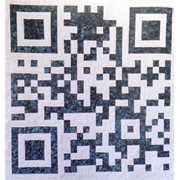There is nothing mysterious about a pantograph. It's a pattern. Oh sure, it's a LARGE pattern - if you own a longarm or shortarm quilting machine, it's on a stand six to twelve feet wide. There's a shelf that runs over the entire sewing area - a shelf that doesn't support much weight, because it's only meant to support the pantograph - a long piece of paper, basically!
But you cans use all the old-fashioned techniques to make your own pantographs: From hand-tracing your pattern, to sewing without thread in your machine through layers of paper, to stamping and photocopying.
Just measure the size of your quilt block. (If you're not using blocks, just measure the size or sizes of the areas you want to fill with quilting.)
If your finished block is ten inches wide, and you have a four-inch stencil or pattern that you really like, you can use any method you like to enlarge the pattern to five inches, or to just below five inches if you want to leave some space.
These days, a lot of people scan a pattern and print it out at different sizes. You tell your computer (or your husband or teenager) to make you printouts at 125%, 137%, or 0.92%.... Start with 125%, 150%, 175%, see if any of them fit. It's like playing the "higher or lower" game on The Price is Right. Just keep doggedly printing different sizes till you get one that fits.
Then cut it out exactly edge-to-edge and double-check. Once you have your first pattern that fits, all you have to do is get multiples of it and tape them together.
Now, if you want to get fancy, you can draw a line along the top or bottom, or both if you're seriously obsessive. That way you can line up each of the copies. Use your quilting rulers to make sure they're "square", meaning 90 degrees, not tilted slightly.
But all you have to do is get them all in a straight line that lies edge-to-edge with your quilt, and presto! You have your very own pantograph.
I'm not overly-fond of the pantograph myself - I'm comfortable with a "meander". Meandering is like an aimless walk - there's no particular pattern or direction. But I have a good eye and I'm confident that if I watch what I'm doing it'll turn out all right. Others aren't so confident and prefer to follow a pattern, so the pantograph is excellent for them. No guessing!
Oh, and when you're finished you first line, you can flip your pantograph upside-down to get a mirrored pattern if you like.
But rest assured it's not rocket science. It's just measuring and duplicating. Tedious, painstaking, and dull - but if you're a quilter, you've already got those skills nailed!
Wednesday, August 13, 2008
Subscribe to:
Post Comments (Atom)






No comments:
Post a Comment